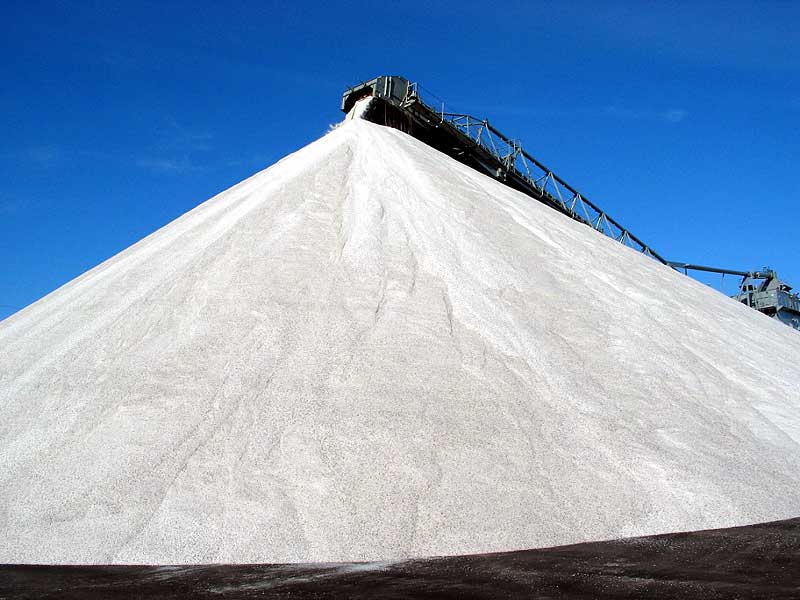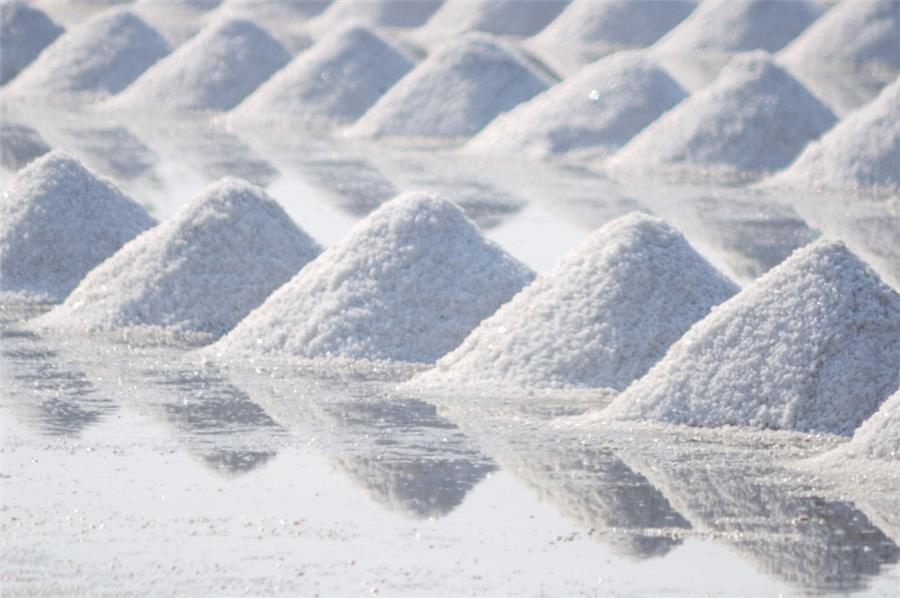Top Stories
Wars Of The Saline Kind


Salt is no longer a humble commodity in Mumbai. It is the cause of a growing conflagration between the state, salt industry, developers and land sharks. At the root of the problem lies 5,500 acres of prime land on the eastern and western fringes of the crowded metropolis where the core activity is salt panning, and which is becoming the abject object of the all-consuming greed of land sharks.
In the corridors of power, not many would have heard of the salt department, which functions under the Union Ministry of Commerce and Industry. And In the Mumbai Metropolitan Region where real estate is worth its weight in gold, the department assumes immense significance by virtue of controlling large tracts of salt pans. In Greater Mumbai alone these lands are spread over 5,500 acres. In a land-starved city where even a pocket-sized plot fetches crores of rupees, salt pans are seen as a potential land development opportunity by the powerful builders’ lobby.
For the uninitiated, salt pans are low-lying swathes near the sea where salt is obtained by evaporation of seawater. But if a huge swathe fringes the city that never sleeps, land sharks can never be far away, for this stretch can easily prove to be the next veritable real estate bonanza for private builders and developers.
The salt pan land is spread across Ghatkopar, Chembur, Mandale, Turbhe, Anik, Wadala, Kanjurmarg, Bhandup, Nahur and Mulund in the eastern suburbs and Malvani, Dahisar, Mira-Bhayander and Virar in the western suburbs of Mumbai. Largely owned by the Centre-run salt department, these salt pans are strategically located near railway stations or along the highway, although they were leased to salt manufacturers decades ago.
Now many of these salt manufacturers have surreptitiously tied up with builders to develop these lands in case the government decides to open the min the future.
It is not just the builders who are eying the land for its commercial exploitation, even the state government is after the salt pans now. It wants the thousands of acres of salt pan land unlocked for the rehabilitation of the slum dwellers and project-affected people.
Maharashtra Chief Minister Prithviraj Chavan has sought the Centre’s consent for development of salt pan land to create affordable housing in Mumbai. After recently discussing with the ministries of urban development and planning and finance the challenges before the state in the housing and slum rehabilitation sectors in Mumbai, Chavan has asked the Centre to initiate the process of releasing salt pan land, which could help the administration consider affordable housing and rehabilitation of slum colonies on prime land.
“If salt pan land is released it would go a long way in redevelopment, which would help the administration work out a formula to promote affordable housing and relocate slums illegally existing on prime land that will have to be acquired for projects,” Chavan said.
“There is no clarity on how much of the 5,500 acres belongs to the state and how much to the Centre. Attempts to work out a formula have met with resistance from central ministries,” said a Mantralaya official, pointing out that there is a problem regarding the land-sharing ratio between the state government and the Centre and that is why the latter has failed to take decisions regarding the salt pan land. In 2006, when the state government came up with a comprehensive housing policy it had suggested that salt pan land be shared equally.
Meanwhile, even as the state is trying to work out a formula for the development of the salt pan land, encroachment on salt pan land is growing with nearly 1,110 acres already under the encroachers.
Selling on the Sly
Deals between realty firms and salt manufacturers to commercially exploit large swaths of salt pans in future have forced the salt department to step in. Over the past decade, the salt department has been busy fighting cases in various courts trying to protect its land. In the latest case, it publicly declared that a 500-acre salt pan sprawl in the eastern suburb of Bhandup belongs to it and warned the public not to enter into any sale or lease agreement with regard to the plot.
“Public is cautioned not to enter into any agreement by way of sale, lease, mortgage, gift, tenancy or any other interest of whatsoever nature, failing which, they will be responsible for the cost and consequences,” the salt department said in a recent public notice.
The land in question was leased out to the Arthur and Jenkins Salt Works which is located on both sides of the Eastern Express Highway. This 500-acre of salt pan land was leased by the Centre to the Garodia family to manufacture salt around 60 years ago. According to property market sources, construction giant Shapoorji Pallonji has now tied up with the Garodias (who built Garodia Nagar in Ghatkopar) to build on the land in case the Centre decides to throw salt pans open for development. The Memorandum of Understanding, the sources said, involves Shapoorji paying close to `500 crore to the Garodias for development rights. The Garodias would also receive 9 per cent of the total built up area. While Mahesh Garodia was unavailable for comment, Shapoorji Pallonji did not respond to a questionnaire sent by Realty & More.
Sensing that the developments, the salt department said it terminated the Garodias’ lease about a decade ago though it was to expire only in 2017 because “they were cultivating grass and not manufacturing salt as the lease deed mandated”. The Garodias filed a suit against the department and the case is still pending in Bombay High Court.
The salt department has also raised a red flag against an alleged bid to grab 950 acres of salt pans in Pen Taluka of Raigad district, about 80 km from Mumbai. The salt department said a construction firm was illegally negotiating with salt cultivators and labourers and paying them off to acquire the land for an upcoming township project. An official of the salt department, who is not authorised to speak to the media on condition of anonymity, said that though the department controlled all salt pans, many salt manufacturers have staked ownership and dragged the department to court.
Historically, salt pan lands were leased out to salt manufacturers by the government, who in turn, subleased them to cultivators. The department official said cultivators have no right over the land and cannot negotiate with any third party.
The salt department official suspected prominent realty firms are surreptitiously signing agreements with salt manufacturers, who are mere lessees. Over the past seven years, it has issued several notices to warn the public that salt manufacturers and private interests are offering to sell salt pan lands to private builders. The central government’s contention is that these parties were allotted salt pans solely for the purpose of manufacturing salt and, therefore, can’t claim ownership on the basis of such licenses.
Political Lobbying
The release of 5,500 acres salt pan land for development is expected to top the agenda of the new government, irrespective of which coalition comes to power. In fact, several months before the Lok Sabha and Maharashtra assembly elections, hectic lobbying is already on in Mumbai and New Delhi to open up the vast tracts of land in the suburbs. But the move has been put on hold by the Congress-led UPA government at the Centre after MP Milind Deora and other prominent citizens raised an alarm over the move. Deora took up the matter at the highest level of Congress and warned that the party would unwittingly become a party to the disaster that would befall Mumbai if the proposal is pushed through. Deora, citing the opinion of environmentalists like Bittu Sehgal said Mumbai would witness heavy flooding if the salt pans, which now function like balancing chambers, are developed.
Industry View
The Federation of Indian Chambers of Commerce and Industry (FICCI) has favoured the exploitation of these lands for real estate purposes, but some of its prominent members like Abhishek Lodha have vehemently opposed the move. But regardless of that, builders have started building pressure on political parties to incorporate the development of housing projects on the salt pans trying to justify their demand on the pretext that there is no land left in Mumbai except the salt pans.
Lodha had objected in writing to a paper prepared by Pranay Vakil, co-chairman of the FICCI real estate committee (Western Zone), which favoured the commercial exploitation of these lands. Lodha wrote to FICCI, saying: “I am not in agreement with the view that salt pans should be developed. I believe that these lands are a vital buffer for the city…I do not believe that FICCI should take a stance which will be in opposition to public sentiment…”
“Even though I am a builder, I think all of us should place the interest of Mumbai before any personal interest,” said Lodha. According to the FICCI report, Mumbai would “greatly benefit from the availability of more land”.
Citing a BMC report, FICCI has said the population of central suburbs like Chembur, Mulund and Ghatkopar is expected to rise from40.64 lakh to 49.03 lakh by 2015. “Amajor share of the salt pans is located in the central suburbs and development of this land could alleviate not only the burden of the aforementioned population increase but also the pressure on Mumbai real estate prices…,” it reasoned.


Abhishek Lodha, MD, Lodha Group


Chandrashekhar Prabhu, Urban Planner
Coastal Regulations
Land sharks eyeing Mumbai’s eco-sensitive salt pans may be disappointed after a government study showed barely 16 percent of it may be available for development. The report said around 3,766 acres or 69 per cent of salt pans are out of bounds because they fall under the stringent coastal regulation zone 1 while another 1,464 acres are encroached or utilised.
The city’s rapidly disappearing open spaces could suffer a death blow if the politician-builder nexus succeeds in throwing open the sprawling salt pans to build towers and shopping complexes. Although the state government claims it wants to resettle project affected persons and slum dwellers on salt pans, not many believe its noble intentions. Many builders have already tied up with salt pan owners and procured power of attorney from them in case these lands are opened up for development.
High Tide Buffer
Like the once flourishing mangroves, now fast dwindling after ruthless hacking by the land mafia, the salt pan tracts act as a vital buffer during high tide. Without them, Mumbai would become increasingly vulnerable, especially during the monsoon, to the kind of intense flooding that had wrought havoc in the city on July 26, 2005. Those who are inclined to dismiss the prediction as a doomsday scenario need look no farther than the neighbouring coastal city of Karachi in Pakistan, where the rampant reclamation of salt pans has made it hostage to tsunami-like floods during its brief monsoon.
At the highest political and government levels in Delhi, there is a view that salt pan lands should not be opened up for any kind of development.


Rishi Aggarwal, Environmental Activist


Milind Deora, Union Minister.


Prithviraj Chavan, Chief Minister, Maharashtra.
Opening saltpans for development will decongest the city considerably and ease the housing shortage. This would automatically
ensure a fall in prices.
Anuj Puri, Chairman & Country Head, India, Jones Lang LaSalle.
Former Union Minister of Environment and Forests Jairam Ramesh said on the sidelines of a meeting to discuss proposals to strengthen Coastal Regulation Zone (CRZ) norms in Mumbai that there is a concern at this high level not to precipitate and take any hasty decision on this issue. “These are valuable lands and there has to be a study on the social and ecological impact of any such move,” he said. The minister said that he was aware that a section of the political class wanted Mumbai’s salt pans to be opened up for development.
Until now, most of Mumbai’s salt pans have escaped the brick-and-mortar onslaught only because they fall into the protected no-development zone — but even this is no longer a sacrosanct cordon. In the past, the powerful builder lobby wanted the government to increase FSI on salt pan lands. Fortunately, this insane idea has still not been approved.
Said Chandrashekhar Prabhu, an urban planner: “Opening up saltpans is a bad idea. Every city has its share of dissipation spaces — wetlands, wastelands, mangroves and salt pan lands. These act like sponges and take the pressure out of the high tide. In the past 10 years, each of these has been destroyed systematically in Mumbai. It is a carefully planned strategy. It is a transition from wetland to wasteland.”
The salt pan land is spread across Ghatkopar, Chembur, Mandale, Turbhe, Anik, Wadala, Kanjurmarg, Bhandup, Nahur and Mulund in the eastern suburbs and Malvani, Dahisar, Mira- Bhayander and Virar in the western suburbs of Mumbai.
It is not just the builders who are eying the land for its commercial exploitation, even the state government is after the salt pans now. It wants the thousands of acres of salt pan land unlocked for rehabilitation of the slum dwellers and project-affected people.
Historically, salt pan lands were leased out to salt manufacturers by the government, who in turn, subleased them to cultivators. The department official said cultivators have no right over the land and cannot negotiate with any third
party.
The salt department official suspected prominent realty firms are surreptitiously signing agreements with salt manufacturers, who are mere lessees.
With several months before the Lok Sabha and Maharashtra assembly elections, hectic lobbying is already on in Mumbai and New Delhi to open up the vast tracts of land in the suburbs. But the move has been put on hold by the Congress-led
UPA government at the Centre after MP Milind Deora and other prominent citizens raised an alarm over the move.
Like the once flourishing mangroves, now fast dwindling after ruthless hacking by the land mafia, the salt pan tracts act as a vital buffer during high tide. Without them, Mumbai would become increasingly vulnerable, especially during the monsoon, to the kind of intense flooding that had wrought havoc in the city on July 26, 2005
-



 News3 weeks ago
News3 weeks agoNoida’s High-Rise Societies Face Multiple Challenges Despite Rapid Urban Growth
-



 News3 weeks ago
News3 weeks agoOlive Announces Dhruv Kalro as Co-Founder
-



 News4 weeks ago
News4 weeks agoGodrej Properties Sells 5000+ Homes of Rs 9.5 cr in Q4FY24, Bookings up 84% YoY
-



 News4 weeks ago
News4 weeks agoVestian: Domestic Investors Dominate Institutional Investments in Jan-Mar’24
-

 News3 weeks ago
News3 weeks agoIndia to become the fastest-growing silver economy, housing up to 17% of the world’s elderly population by 2050: CBRE Report
-



 News4 weeks ago
News4 weeks agoHRERA Gurugram Rejects Godrej Properties’ Project Extension Application, Account Frozen For Prolonged Non-compliances
-



 News2 weeks ago
News2 weeks agoSKA Forays In Luxury Housing: Launches SKA Destiny One in Greater Noida, To Invest Rs 592 Crores
-



 News4 weeks ago
News4 weeks agoAshiana Housing Sells Rs 440 cr Worth 224 Flats at its Project Amarah in Gurugram




























